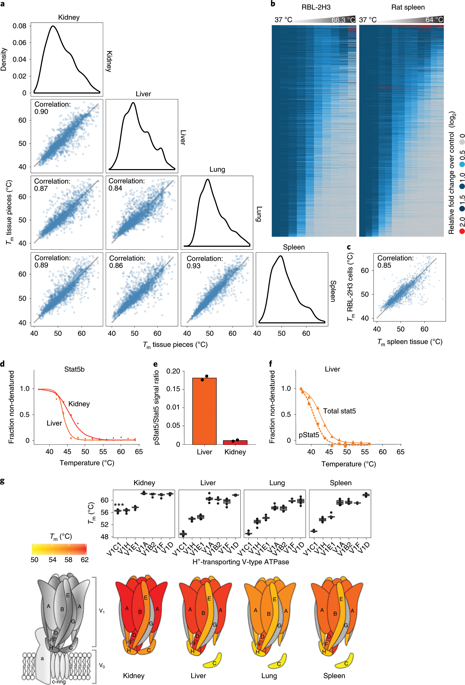Nature Biotechnology ( IF 33.1 ) Pub Date : 2020-01-20 , DOI: 10.1038/s41587-019-0388-4 Jessica Perrin 1 , Thilo Werner 1 , Nils Kurzawa 2 , Anna Rutkowska 1 , Dorothee D Childs 2 , Mathias Kalxdorf 1 , Daniel Poeckel 1 , Eugenia Stonehouse 1 , Katrin Strohmer 1 , Bianca Heller 1 , Douglas W Thomson 1 , Jana Krause 1 , Isabelle Becher 2 , H Christian Eberl 1 , Johanna Vappiani 1 , Daniel C Sevin 1 , Christina E Rau 1 , Holger Franken 1 , Wolfgang Huber 2 , Maria Faelth-Savitski 1 , Mikhail M Savitski 2 , Marcus Bantscheff 1 , Giovanna Bergamini 1

|
Monitoring drug–target interactions with methods such as the cellular thermal-shift assay (CETSA) is well established for simple cell systems but remains challenging in vivo. Here we introduce tissue thermal proteome profiling (tissue-TPP), which measures binding of small-molecule drugs to proteins in tissue samples from drug-treated animals by detecting changes in protein thermal stability using quantitative mass spectrometry. We report organ-specific, proteome-wide thermal stability maps and derive target profiles of the non-covalent histone deacetylase inhibitor panobinostat in rat liver, lung, kidney and spleen and of the B-Raf inhibitor vemurafenib in mouse testis. In addition, we devised blood-CETSA and blood-TPP and applied it to measure target and off-target engagement of panobinostat and the BET family inhibitor JQ1 directly in whole blood. Blood-TPP analysis of panobinostat confirmed its binding to known targets and also revealed thermal stabilization of the zinc-finger transcription factor ZNF512. These methods will help to elucidate the mechanisms of drug action in vivo.
中文翻译:

通过热迁移分析识别组织和全血中的药物靶点
对于简单的细胞系统,使用诸如细胞热迁移测定 (CETSA) 等方法监测药物-靶标相互作用已经很成熟,但在体内仍然具有挑战性。在这里,我们介绍了组织热蛋白质组分析 (tissue-TPP),它通过使用定量质谱法检测蛋白质热稳定性的变化来测量小分子药物与药物治疗动物组织样本中蛋白质的结合。我们报告器官特异性、蛋白质组范围的热稳定性图,并得出大鼠肝脏、肺、肾脏和脾脏中非共价组蛋白去乙酰化酶抑制剂帕比司他和小鼠睾丸中 B-Raf 抑制剂威罗非尼的目标谱。此外,我们设计了血液-CETSA 和血液-TPP,并将其应用于直接在全血中测量帕比司他和 BET 家族抑制剂 JQ1 的靶向和脱靶参与。panobinostat 的血液-TPP 分析证实了它与已知靶标的结合,并且还揭示了锌指转录因子 ZNF512 的热稳定性。这些方法将有助于阐明体内药物作用的机制。











































 京公网安备 11010802027423号
京公网安备 11010802027423号